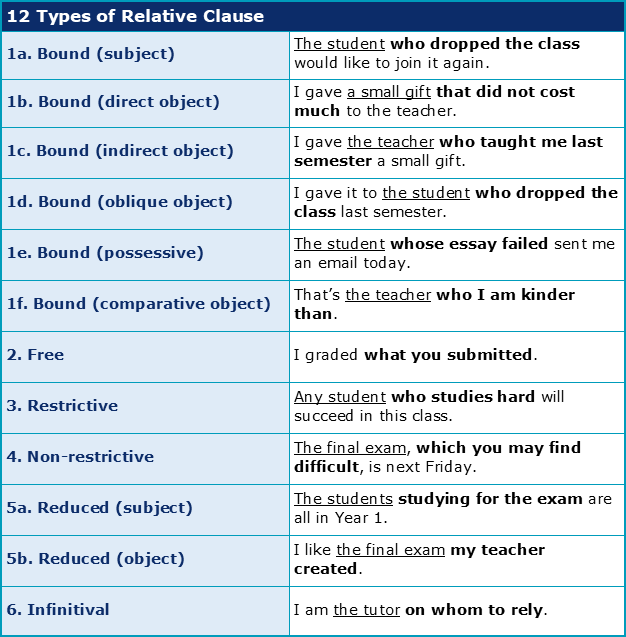What are relative clauses and are they important?

This is the first of three chapters about Relative Clauses. To complete this reader, read each chapter carefully and then unlock and complete our materials to check your understanding.
– Review the concepts of dependent and independent clauses
– Discuss the unique features of relative clauses
– Explore the benefits of relative clauses and why they are important for academic writing
Before you begin reading...
-
video and audio texts
-
knowledge checks and quizzes
-
skills practices, tasks and assignments
Chapter 1
Although many students may be uncertain about what a clause is exactly, most will have heard of relative clauses when studying English grammar. Also known as adjective clauses because they modify nouns like adjectives do, relative clauses are common and very useful. However, because of their variation and rules they can be quite challenging too. In this three-chapter reader on the topic, we therefore discuss the basic concepts of relative clauses (Chapter 1), explore the twelve types that exist (Chapter 2) and highlight and exemplify their eight most helpful grammar rules (Chapter 3).

What is a clause?
There are some key features of clauses that students should review before focussing more specifically on the relative clause. In short, clauses:
- contain at least a subject and a verb phrase function
- may also comprise objects, complements and adverbials
- can be categorised into independent and dependent types
- are the building blocks of simple, compound and complex sentence structures
- may be combined using coordinating conjunctions (‘and’; ‘but’), subordinating conjunctions (‘although’; ‘because’), conjunctive adverbs (‘however’; ‘therefore’), commas (,) and semicolons (;)
What are dependent clauses?
Whether a clause is dependent or independent relates to whether that clause forms a grammatical sentence on its own. To see this in action, let’s a look at two examples:


In the first example, there is one independent clause forming a simple sentence, and in the second there are two clauses (one dependent and one independent) forming a complex sentence. The independent clauses ‘I speak English’ and ‘I know the subject well’ are independent because they can form grammatical sentences on their own without combination with any other clause. The dependent clause ‘because I teach biology’, however, can not: Dependent clauses must be joined to other clauses to form grammatical sentences.

What makes relative clauses special?
Relative clauses, then, are types of dependent clause. Like all clauses, they contain a subject and a verb, but relative clauses are special in that they’re specifically designed to define, identify or provide extra information about a noun or noun phrase. To see this in action, let’s take a look at the two examples below. Can you identify how many clauses are in these two sentences and which words form the relative clause? Are there any special words which identify relative clauses?


…What you may have hopefully identified is that sentence (A) has two clauses and sentence (B) has three. These distinctions are numbered in the following examples, with the relative clauses highlighted in bold:


In both (A) and (B), the relative clauses ‘who teaches biology’ and ‘that we use for biology’ are adding defining features to their directly preceding nouns. In other words, these clauses are further describing ‘the man with the beard’ and ‘the classroom’ by adding defining features to those noun phrases.
Which words introduce relative clauses?
What you may have also noticed in these examples is that relative clauses are generally introduced in English using specific words. These words are known as relative pronouns, and they each have a different form and function:

However, as we will learn in Chapters 2 and 3, relative clauses can also sometimes be introduced by the pronouns ‘what/whatever’ and ‘whoever/whomever’ and the adverbs ‘where’ and ‘when’. Let’s take a look at some examples of each:
- The student that always wears a suit is never on time.
- Open the book which we were using last week.
- The student who always wears a suit is never on time.
- Give it to the student whom I reprimanded yesterday.
- The student whose hair is red is always on time.
- I graded what you’ve submitted.
- That was the university where we met.
- It was the year when we graduated.

Why are relative clauses important?
Clearly, relative clauses are frequently used and are helpful for English speakers, but because this grammatical structure is easy to make mistakes with, it’s important that students are able to form and use such clauses correctly. This is especially true if you wish to write accurate and coherent essays and receive high grades, and if you wish to make your writing more concise. To reduce your word count, for example, or increase the dynamism of your sentence structures, you may wish to combine two existing sentences into one sentence that uses a relative clause:


How many types of relative clause exist?
If you feel comfortable with the basic concepts of relative clauses, continue reading with Chapter 2 to learn about their 12 types, which we’ve listed below:

However, before moving on to Chapter 2, you may first wish to unlock, download and complete our Chapter 1 Worksheet to check your knowledge of relative clauses so far and improve your English proficiency.
Downloadables
Once you’ve completed all three chapters in this short reader about Relative Clauses, you might then wish to download our Chapter Worksheets to check your progress or print for your students. These professional PDF worksheets can be easily accessed for only a few Academic Marks.
Chapter 1 explores the topic: What are relative clauses and are they important? Our Chapter 1 Worksheet (containing guidance, activities and answer keys) can be accessed here at the click of a button.
Chapter 2 explores the topic: What are the 12 types of relative clause in English? Our Chapter 2 Worksheet (containing guidance, activities and answer keys) can be accessed here at the click of a button.
Chapter 3 explores the topic: Which 8 rules make relative clauses grammatical? Our Chapter 3 Worksheet (containing guidance, activities and answer keys) can be accessed here at the click of a button.
To save yourself 2 Marks, click on the button below to gain unlimited access to all of our Relative Clauses Chapter Worksheets. This All-in-1 Pack includes every chapter, activity and answer key related this topic in one handy and professional PDF.
Collect Academic Marks
-
100 Marks for joining
-
25 Marks for daily e-learning
-
100-200 for feedback/testimonials
-
100-500 for referring your colleages/friends